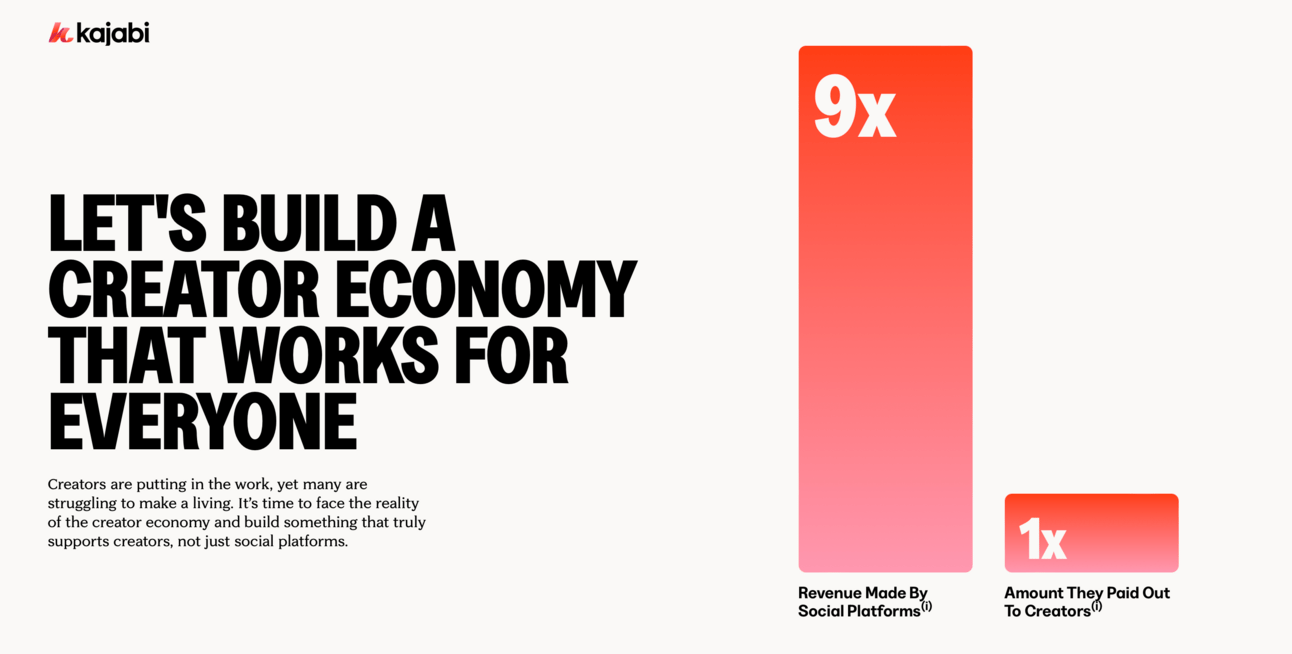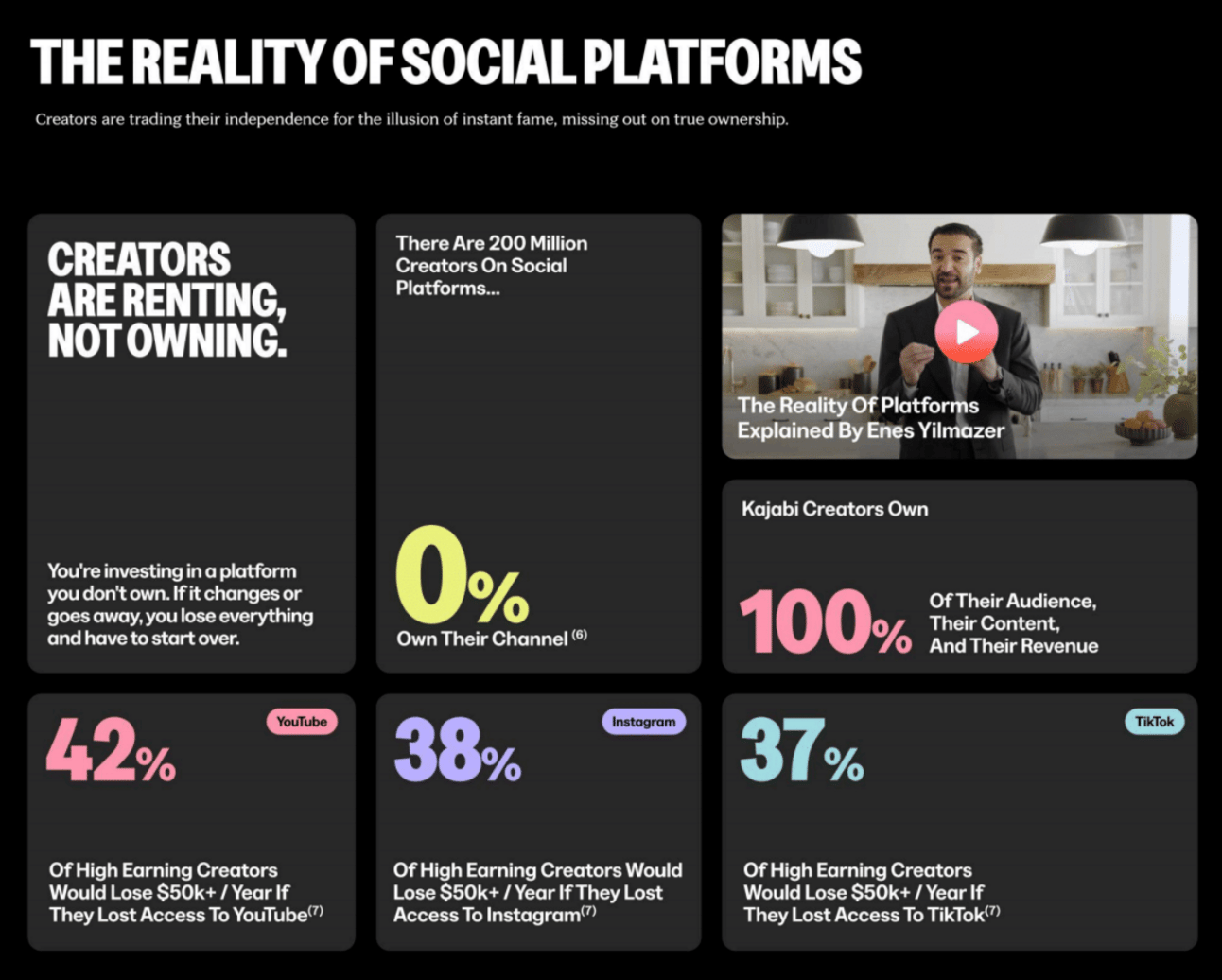
Kajabi / The Reality of the Creator Economy
The creator economy is estimated to be worth over $480 billion by 2027, according to Goldman Sachs. While this impressive statistic often dominates discussions about the space, what's rarely mentioned is that social media platforms are benefiting the most.
Ahad Khan, CEO of Kajabi, highlighted this in our recent conversation ahead of the company’s new campaign, The Reality of the Creator Economy. This campaign features a rebrand, new products, creator billboards, and a report exploring the harsh truths of revenue sharing, the impact of algorithms on creator success, and how creators can build sustainable followings without relying on mega-fame or viral moments.
Kajabi has powered over $8 billion in creator revenue by helping creators build, distribute, and monetize their businesses—all in one place. From courses and memberships to newly launched products like newsletters and downloads, Kajabi offers multiple avenues for creators to monetize their expertise.
Key Themes from Our Discussion
During our discussion, we unpacked key themes from the report and the broader realities of the creator economy, including:
The widening revenue gap between creators and social platforms.
Strategies for creators to establish sustainable businesses on their own channels.
What’s stopping creators from monetizing directly with their audience.
The role of brand deals within a creator's revenue model.
Kajabi’s entry into the crowded newsletter space.
Issues influencing creators' voting decisions.
The Challenges Creators Face

Kajabi / The Reality of Revenue Sharing
“Platforms are making billions while creators are struggling with real problems,” Khan said. He’s right; creators face challenges ranging from algorithm changes and mental health struggles to burnout and figuring out sustainable income streams.
Even though the creator economy is booming, platform payouts barely scratch the surface for most creators, especially considering that creators—who generate all the value—often see just pennies compared to the platforms themselves. For instance, for every $1,000 TikTok makes, creators receive just $6.25. Plus, nearly a quarter of creators work for two years before seeing a single dollar while social media platforms continue to profit off a creator’s content.
Despite these issues, Khan doesn’t think it’s an "either-or" situation when it comes to building on social media platforms (rented spaces) versus Kajabi. It’s more of an "and." Social media platforms like YouTube, TikTok, Instagram, and LinkedIn are great for building an audience, but they aren’t ideal for building a sustainable business.
“The right way to build a business is on a platform you own,” he said, where creators own their audience—email lists, customers, DMs—without an intermediary. With this, creators can then answer crucial questions about their audiences:
How much did they pay?
Are they valuable?
Am I ROI positive?
How can I sell to them?
According to Kajabi, nearly 50% of creators make under $10K a year.
The Reality of Brand Deals
The same is true for brand deals, a world I’m familiar with. Creators make money by promoting products and services for companies.
Like social media platforms, brand deals are another "and"—great when marketing dollars are flowing, as we saw during the height of the pandemic when creators became go-tos for brands to not only spread awareness about products but also create marketing assets across their channels. However, when marketing budgets tighten—like we’re seeing with high-interest rates and economic uncertainty—it gives companies more leverage and leaves creators in a tough spot.
Many are forced to push products they don’t believe in just to pay the bills or sacrifice creative control. According to Kajabi's report, 46% of creators struggle to maintain creative control when working with brands, and 45% find it challenging to negotiate fair compensation.
Why Aren’t More Creators Selling Directly?

Kajabi / The Reality of Views
What’s stopping creators from jumping onto platforms like Kajabi or more generally selling directly to their audiences?
“Everyone underestimates their capabilities and their ability to monetize what they know,” Khan said. He pointed out that creators often undervalue themselves and fear their audience will think they're just "nickel-and-diming" them. But he emphasized that if a creator has an audience, that’s a clear sign they have something people find valuable. Not everyone who follows you on social will pay, but a percentage will.
Creators need to think of themselves as businesses or entrepreneurs, operating with a marketing funnel mindset—starting at the top and converting people at the bottom. The key is putting valuable content into the world.
I can speak from firsthand experience about the challenges creators face when going directly to their audience. As I’ve transitioned from a 9-to-5 worker to a solopreneur—where part of my work involves being a creator—I’ve been grappling with the best way to add a revenue stream outside of consulting, advising, and brand partnerships. Should I offer a paid version of my newsletter or launch a community?
For those of us who have put out so much content for free, it can be tough to make the leap to selling, even when you know the content is valuable.
How Should Creators Monetize First?
When creators are ready to monetize directly, the question becomes: how should they do it? As you’d expect, it’s nuanced and depends largely on the creator and their audience.
Khan suggests starting with digital downloads due to the lighter lift compared to a full course. Downloads can also provide early income and give creators signals on what their audience is interested in. More specifically, coaches may find it easier to start with a coaching product, while writers might begin with a newsletter—offering some content for free and charging for premium insights.

Kajabi / Newsletters
Kajabi’s new newsletter product marks its entry into a rapidly growing segment. Platforms like Substack, beehiiv, Kit (formerly ConvertKit), and Ghost cater specifically to independent creators and journalists. Newsletters have gained traction among creators as a way to have direct access to their audiences and the opportunity to monetize.
Khan doesn’t see these platforms as direct competition; rather, he views them as point solutions. “They scratch one itch really well. I love those products, but we’re more of a horizontal platform where creators can build income in a more flexible way,” he explained.
The addition of newsletters provides creators on Kajabi another opportunity to monetize under one roof.
Key Issues Influencing Creators’ Voting Decisions
As the upcoming election approaches, Kajabi’s report highlights how creators are shaping their voting decisions. Key issues influencing their choices include:
Fair pay for creators (57%).
Regulation of social media platforms (48%).
Copyright law and fair use policies (47%).
Creators and politics have become much more prominent in conversations today. This year has been significant, with the White House hosting its first-ever Creator Economy Conference to discuss pressing issues for creators—many of which overlap with what creators say influence their voting. We’ve also seen both presidential candidates enlist creators to help convey their messages and reach specific audiences.
Creators are now recognized as a distinct class and industry, prompting many to engage in political discourse that impacts their work on digital platforms, similar to how small business owners or certain industries like technology or agriculture consider their votes based on economic implications.
“And I’m happy to see the ecosystem thinking of itself as an industry. Creators are realizing the importance of getting organized, engaging with politicians, and ensuring their voices are heard in the decision-making process. That’s how the system should work,” Khan said.
The Key Takeaway

Kajabi / The Reality of Social Platforms
While social media platforms are crucial for audience growth, long-term success depends on transitioning followers to owned platforms. Here, creators gain greater control and insights into their content and audience, allowing them to leverage data effectively and sell directly based on their followers' needs.
Although some creators currently rely solely on brand deals and revenue-sharing models, embracing the true business aspect of being a creator entrepreneur means taking ownership of revenue streams. This shift will help creators achieve financial stability, maintain creative control over their work, and, most importantly, establish the middle class of creators that has been promised.
For more on Kajabi’s The Reality of The Creator Economy, visit here.
GO DEEPER
Here are some previous editions of the newsletter that cover topics related to the this, if you’re interested in diving deeper:
THANK YOU
Thank you for reading! If you've enjoyed this, please consider sharing it with a colleague or friend and/or supporting it via Buy Me A Coffee. If you have any feedback, ideas, tips, or questions or would like to advertise in the newsletter or collaborate, please don't hesitate to reply to this email, reach out here, or send me a DM.
